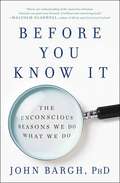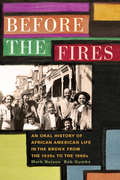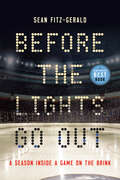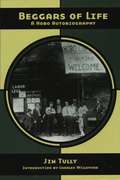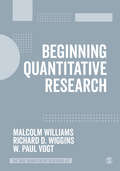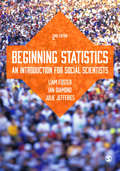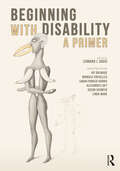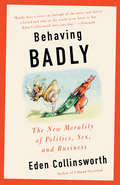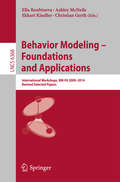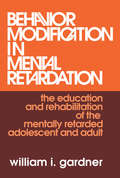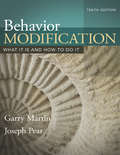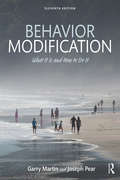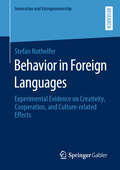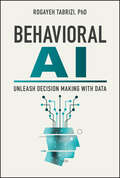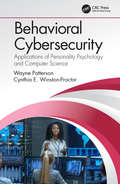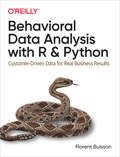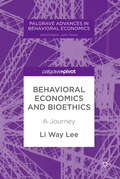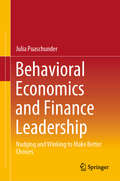- Table View
- List View
Before You Know It: The Unconscious Reasons We Do What We Do
by John BarghDr. John Bargh, the world’s leading expert on the unconscious mind, presents a groundbreaking book, twenty years in the making, which gives us an entirely new understanding of the hidden mental processes that secretly govern every aspect of our behavior.For more than three decades, Dr. John Bargh has been responsible for the revolutionary research into the unconscious mind, research that informed bestsellers like Blink and Thinking Fast and Slow. Now, in what Dr. John Gottman said “will be the most important and exciting book in psychology that has been written in the past twenty years,” Dr. Bargh takes us on an entertaining and enlightening tour of the forces that affect everyday behavior while transforming our understanding of ourselves in profound ways. Telling personal anecdotes with infectious enthusiasm and disclosing startling and delightful discoveries, Dr. Bargh takes the reader into his labs at New York University and Yale where he and his colleagues have discovered how the unconscious guides our behavior, goals, and motivations in areas like race relations, parenting, business, consumer behavior, and addiction. He reveals what science now knows about the pervasive influence of the unconscious mind in who we choose to date or vote for, what we buy, where we live, how we perform on tests and in job interviews, and much more. Because the unconscious works in ways we are completely unaware of, Before You Know It is full of surprising and entertaining revelations as well as tricks to help you remember to-do items, shop smarter, and sleep better. Destined to be a bestseller, Before You Know It is an intimate introduction to a fabulous world only recently discovered, the world that exists below the surface of your awareness and yet is the key to knowing yourself and unlocking new ways of thinking, feeling, and behaving.
Before the Collapse: A Guide to the Other Side of Growth
by Ugo BardiNobody has to tell you that when things go bad, they go bad quickly and seemingly in bunches. Complicated structures like buildings or bridges are slow and laborious to build but, with a design flaw or enough explosive energy, take only seconds to collapse. This fate can befall a company, the stock market, or your house or town after a natural disaster, and the metaphor extends to economies, governments, and even whole societies. As we proceed blindly and incrementally in one direction or another, collapse often takes us by surprise. We step over what you will come to know as a “Seneca cliff”, which is named after the ancient Roman philosopher, Lucius Annaeus Seneca, who was the first to observe the ubiquitous truth that growth is slow but ruin is rapid. Modern science, like ancient philosophy, tell us that collapse is not a bug; it is a feature of the universe. Understanding this reality will help you to see and navigate the Seneca cliffs of life, or what Malcolm Gladwell called “tipping points.” Efforts to stave off collapse often mean that the cliff will be even steeper when you step over it. But the good news is that what looks to you like a collapse may be nothing more than the passage to a new condition that is better than the old.This book gives deeper meaning to familiar adages such as “it’s a house of cards”, “let nature take its course”, “reach a tipping point”, or the popular Silicon Valley expression, “fail fast, fail often.” As the old Roman philosopher noted, “nothing that exists today is not the result of a past collapse”, and this is the basis of what we call “The Seneca Strategy.” This engaging and insightful book will help you to use the Seneca Strategy to face failure and collapse at all scales, to understand why change may be inevitable, and to navigate the swirl of events that frequently threaten your balance and happiness. You will learn:How ancient philosophy and modern science agree that failure and collapse are normal features of the universePrinciples that help us manage, rather than be managed by, the biggest challenges of our lives and times Why technological progress may not prevent economic or societal collapseWhy the best strategy to oppose failure is not to resist at all costsHow you can “rebound” after collapse, to do better than before, and to avoid the same mistakes.
Before the Fires: An Oral History of African American Life in the Bronx from the 1930s to the 1960s
by Mark D. Naison Bob GumbsPeople associate the South Bronx with gangs, violence, drugs, crime, burned-out buildings, and poverty. This is the message that has been driven into their heads over the years by the media. As Howard Cosell famously said during the 1977 World’s Series at Yankee Stadium, “There it is, ladies and gentlemen, the Bronx is burning.” In this new book, Naison and Gumbs provide a completely different picture of the South Bronx through interviews with residents who lived here from the 1930s to the 1960s.In the early 1930s, word began to spread among economically secure black families in Harlem that there were spacious apartments for rent in the Morrisania section of the Bronx. Landlords in that community, desperate to fill their rent rolls and avoid foreclosure, began putting up signs in their windows and in advertisements in New York’s black newspapers that said, “We rent to select colored families,” by which they meant families with a securely employed wage earner and light complexions. Black families who fit these criteria began renting apartments by the score. Thus began a period of about twenty years during which the Bronx served as a borough of hope and unlimited possibilities for upwardly mobile black families.Chronicling a time when African Americans were suspended between the best and worst possibilities of New York City, Before the Fires tells the personal stories of seventeen men and women who lived in the South Bronx before the social and economic decline of the area that began in the late 1960s. Located on a hill hovering over one of the borough’s largest industrial districts, Morrisania offered black migrants from Harlem, the South, and the Caribbean an opportunity to raise children in a neighborhood that had better schools, strong churches, better shopping, less crime, and clean air. This culturally rich neighborhood also boasted some of the most vibrant music venues in all of New York City, giving rise to such music titans as Lou Donaldson, Valerie Capers, Herbie Hancock, Eddie Palmieri, Donald Byrd, Elmo Hope, Henry “Red” Allen, Bobby Sanabria, Valerie Simpson, Maxine Sullivan, the Chantels, the Chords, and Jimmy Owens.Alternately analytical and poetic, but all rich in detail, these inspiring interviews describe growing up and living in vibrant black and multiracial Bronx communities whose contours have rarely graced the pages of histories of the Bronx or black New York City. Capturing the excitement of growing up in this stimulating and culturally diverse environment, Before the Fires is filled with the optimism of the period and the heartache of what was shattered in the urban crisis and the burning of the Bronx.
Before the Lights Go Out: A Season Inside a Game on the Brink
by Sean Fitz-GeraldA love letter to a sport that's losing itself, from one of Canada's best sports writers.Canadian hockey is approaching a state of crisis. It's become more expensive, more exclusive, and effectively off-limits to huge swaths of the potential sports-loving population. Youth registration numbers are stagnant; efforts to appeal to new Canadians are often grim at best; the game, increasingly, does not resemble the country of which it's for so long been an integral part. These signs worried Sean Fitz-Gerald. As a lifelong hockey fan and father of a young mixed-race son falling headlong in love with the game, he wanted to get to the roots of these issues. His entry point: a season with the Peterborough Petes, a storied OHL team far from its former glory in a once-emblematic Canadian city that is finding itself on the wrong side of the country's changing demographics. Fitz-Gerald profiles the players, coaches and front office staff, a mix of world-class talents with NHL aspirations and Peterborough natives happy with more modest dreams. Through their experiences, their widely varied motivations and expectations, we get a rich, colourful understanding of who ends up playing hockey in Canada and why. Fitz-Gerald interweaves the action of the season with portraits of public figures who've shaped and been shaped by the game: authors who captured its spirit, politicians who exploited it, and broadcasters who try to embody and sell it. He finds his way into community meetings full of angry season ticket holders, as well as into sterile boardrooms full of the sport's institutional brain trust, unable to break away from the inertia of tradition and hopelessly at war with itself. Before the Lights Go Out is a moving, funny, yet unsettling picture of a sport at a crossroads. Fitz-Gerald's warm but rigorous journalistic approach reads, in the end, like a letter to a troubled friend: it's not too late to save hockey in this country, but who has the will to do it?
Before the Nation: Kokugaku and the Imagining of Community in Early Modern Japan
by Susan L. BurnsExploring the emergence and evolution of theories of nationhood that continue to be evoked in present-day Japan, Susan L. Burns provides a close examination of the late-eighteenth-century intellectual movement kokugaku, which means "the study of our country. " Departing from earlier studies of kokugaku that focused on intellectuals whose work has been valorized by modern scholars, Burns seeks to recover the multiple ways "Japan" as social and cultural identity began to be imagined before modernity. Central to Burns's analysis is Motoori Norinaga's Kojikiden, arguably the most important intellectual work of Japan's early modern period. Burns situates the Kojikiden as one in a series of attempts to analyze and interpret the mythohistories dating from the early eighth century, the Kojiki and Nihon shoki. Norinaga saw these texts as keys to an original, authentic, and idyllic Japan that existed before being tainted by "flawed" foreign influences, notably Confucianism and Buddhism. Hailed in the nineteenth century as the begetter of a new national consciousness, Norinaga's Kojikiden was later condemned by some as a source of Japan's twentieth-century descent into militarism, war, and defeat. Burns looks in depth at three kokugaku writers--Ueda Akinari, Fujitani Mitsue, and Tachibana Moribe--who contested Norinaga's interpretations and produced competing readings of the mythohistories that offered new theories of community as the basis for Japanese social and cultural identity. Though relegated to the footnotes by a later generation of scholars, these writers were quite influential in their day, and by recovering their arguments, Burns reveals kokugaku as a complex debate--involving history, language, and subjectivity--with repercussions extending well into the modern era.
Befristete Beschäftigungsverhältnisse junger Erwachsener: Folgen für Partnerschaft und private Zukunftsgestaltung (Familienforschung)
by Daniel BaronIn den vergangenen drei Jahrzehnten sind die Anteile befristeter Beschäftigungsverhältnisse bei jungen Erwachsenen in der Bundesrepublik Deutschland und in anderen spätkapitalistischen Gesellschaften deutlich angestiegen. Eingebettet in fortdauernde Trends einer Verringerung wohlfahrtsstaatlicher Sicherungsstandards hat diese Entwicklung dazu beigetragen, dass sich Übergänge in stabile berufliche Karrieren und planbare private Zukunftsgestaltungen diversifizieren und verzögern. In der vorliegenden Studie wird eine soziologische Erklärung der Auswirkungen befristeter Beschäftigung auf private und partnerschaftliche Zukunftsgestaltungen von jungen Erwachsenen theoriegeleitet ausgearbeitet und empirisch überprüft. Da mit der Ausweitung befristeter Beschäftigung das klassische männliche Ernährermodell in Begründungsnot gerät, so die zentrale These, werden Neuaushandlungen von Geschlechterrollenarrangements in jungen Partnerschaften erforderlich. Nicht allein sozioökonomische Risiken im Kontext befristeter Beschäftigung, auch die sich wandelnden geschlechter- und erwerbsbezogenen Rollenerwartungen wirken sich verzögernd auf private und partnerschaftliche Zukunftsgestaltungen aus.Die Studie richtet sich an Forschende, Lehrende und Studierende der Soziologie, Politikwissenschaft, Psychologie und in benachbarten sozialwissenschaftlichen Disziplinen. Ebenso adressiert sie methodisch versierte Praktiker*
Beggars of Life: A Hobo Autobiography
by Jim TullyA bestseller in 1924, this vivid piece of outlaw history has inexplicably faded from the public consciousness. Jim Tully takes us across the seamy underbelly of pre-WWI America on freight trains, and inside hobo jungles and brothels while narrowly averting railroad bulls (cops) and wardens of order. Written with unflinching honesty and insight,Beggars of Life follows Tully from his first ride at age thirteen, choosing life on the road over a bdeadening job, through his teenage years of learning the ropes of the rails and -living one meal to the next. Tully’s direct, confrontational approach helped shape the hard-boiled school of writing, and later immeasurably influenced the noir genre. Beggars of Life was the first in Tully’s five-volume memoir, dubbed the "Underworld Edition," recalling his transformation from road-kid to novelist, journalist, Hollywood columnist, chain maker, boxer, circus handyman, and tree surgeon. Jim Tully(1891-1947) was a best-selling novelist and popular Hollywood journalist in the 1920s and ’30s. Known as "Cincinnati Red" during his years as a road-kid, he counted prizefighter and publicist of Charlie Chaplin among his many jobs. He is considered (with Dashiel Hammett) one of the inventors of the hard-boiled style of American writing. In Oakland, California on March 24, 2015 a fire destroyed the AK Press warehouse along with several other businesses. Please consider visiting the AK Press website to learn more about the fundraiser to help them and their neighbors.
Beginning Quantitative Research (The SAGE Quantitative Research Kit)
by Malcolm Williams Richard D. Wiggins W.P. VogtThis concise text provides a clear and digestible introduction to completing quantitative research. Taking you step-by-step through the process of completing your quantitative research project, it offers guidance on: · Formulating your research question · Completing literature reviews and meta-analysis · Formulating a research design and specifying your target population and data source · Choosing an appropriate method and analysing your findings Part of The SAGE Quantitative Research Kit, this book will give you the know-how and confidence needed to succeed on your quantitative research journey.
Beginning Quantitative Research (The SAGE Quantitative Research Kit)
by Malcolm Williams Richard D. Wiggins W.P. VogtThis concise text provides a clear and digestible introduction to completing quantitative research. Taking you step-by-step through the process of completing your quantitative research project, it offers guidance on: · Formulating your research question · Completing literature reviews and meta-analysis · Formulating a research design and specifying your target population and data source · Choosing an appropriate method and analysing your findings Part of The SAGE Quantitative Research Kit, this book will give you the know-how and confidence needed to succeed on your quantitative research journey.
Beginning Statistics: An Introduction for Social Scientists
by Ian Diamond Liam Foster Julie BantonIn the Second Edition of this bestselling textbook, the authors use real-world examples to introduce basic principles in statistics with no prior knowledge or experience assumed. With an emphasis on describing concepts, showing through example and illustrating points with graphs and displays, this book will provide readers with a step-by-step introduction to using statistics. Chapters address the following questions: Why bother learning statistics in the first place and are they relevant to real life? How do I make sensible tables and informative graphs? What are descriptive and inferential statistics and how are they used? What are regression and correlation anyway?
Beginning with Disability: A Primer
by Susan Schweik Lennard J. Davis Nirmala Erevelles Jay Dolmage Linda Ware Sarah Parker Harris Alexander LuftWhile there are many introductions to disability and disability studies, most presume an advanced academic knowledge of a range of subjects. Beginning with Disability is the first introductory primer for disaibility studies aimed at first year students in two- and four-year colleges. This volume of essays across disciplines—including education, sociology, communications, psychology, social sciences, and humanities—features accessible, readable, and relatively short chapters that do not require specialized knowledge. Lennard Davis, along with a team of consulting editors, has compiled a number of blogs, vlogs, and other videos to make the materials more relatable and vivid to students. "Subject to Debate" boxes spotlight short pro and con pieces on controversial subjects that can be debated in class or act as prompts for assignments.
Behaving Badly: The New Morality in Politics, Sex, and Business
by Eden CollinsworthWhat is the relevance of morality today? Eden Collinsworth enlists the famous, the infamous, and the heretofore unheard-of to unravel how we make moral choices in an increasingly complex—and ethically flexible—age. To call these unsettling times is an understatement: our political leaders are less and less respectable; in the realm of business, cheating, lying, and stealing are hazily defined; and in daily life, rapidly changing technology offers permission to act in ways inconceivable without it. Yet somehow, this hasn’t quite led to a complete free-for-all—people still draw lines around what is acceptable and what is not. Collinsworth sets out to understand how and why. In her intrepid quest, she squares off with a prime minister, the editor of London’s Financial Times, a holocaust survivor, a pop star, and a former commander of the U.S. Air Force to grapple with the impracticality of applying morals to foreign policy; precisely when morality gets lost in the making of money; what happens to morality without free will; whether “immoral” women are just those having a better time; why celebrities have become the new moral standard-bearers; and if testosterone is morality’s enemy or its hero.
Behavior Modeling -- Foundations and Applications: International Workshops, BM-FA 2009-2014, Revised Selected Papers (Lecture Notes in Computer Science #6368)
by Ella Roubtsova Ashley Mcneile Ekkart Kindler Christian GerthThis book constitutes revised selected papers from the six International Workshops on Behavior Modelling - Foundations and Applications, BM-FA, which took place annually between 2009 and 2014. The 9 papers presented in this volume were carefully reviewed and selected from a total of 58 papers presented at these 6 workshops. The contributions were organized in topical sections named: modelling practices; new ways of behaviour modelling: events in modelling; and new ways of behaviour modelling: protocol modelling.
Behavior Modification in Mental Retardation: The Education and Rehabilitation of the Mentally Retarded Adolescent and Adult
by William GardnerIn this important book, one of the most exciting and promising developments in clinical psychology-behavior modification is applied to the treatment of the mentally retarded, particularly those whose behavior poses difficult problems for institutions. Professor Gardner presents an easily intelligible yet detailed account of the concepts and practices of behavior modification and the underlying learning systems, with numerous clinical illustrations of applying specific techniques to various educational and rehabilitation problems. A thorough discussion of the inadequacies of the psychological evaluation systems normally used in education and rehabilitation is offered, along with an alternative behavior analysis approach that provides a method of translating evaluation data into treatment practices. In explaining behavior analysis, the author takes into account the limited behavioral repertoire of the retarded and environmental deficits. Individual chapters on respondent, operant, and observational learning, and a detailed discussion of a functional analysis approach to evaluation, are included. Proven behavior modification strategies are presented along with a review of related research and clinical studies. The book closes with a detailed description of a research program for the design and testing of sheltered workshop systems for the retarded and emotionally disturbed. The positive approach inherent in the belief that behavior is modifiable-even in the severely limited retarded-is in marked contrast to the pessimism of other systems of therapy, education, and training. Also, the author has concentrated throughout on making the book understandable to clinicians and students with no previous knowledge of behavior modification. Besides serving as a valuable handbook for all treatment personnel, the book can also be used as a basic text for various courses dealing with mental retardation.
Behavior Modification: What It Is and How To Do It
by Garry Martin Joseph J. PearBehavior Modification,10/e assumes no specific prior knowledge about psychology or behavior modification on the part of the reader. The authors begin with basic principles and procedures of behavior modification and then provide readers with how-to-skills such as observing and recording. Next, the authors provide advanced discussion and references to acquaint readers with some of the empirical and theoretical underpinnings of the field. Readers will emerge with a thorough understanding of behavior modification in a wide variety of populations and settings.
Behavior Modification: What It Is and How To Do It
by Garry Martin Joseph J. PearBehavior Modification: What It Is and How to Do It is a comprehensive, practical presentation of the principles of behavior modification and guidelines for their application. Appropriate for university students and for the general reader, it teaches forms of behavior modification ranging from helping children learn necessary life skills to training pets, to solving personal behavior problems. It teaches practical "how-to" skills, including: discerning long-term effects; designing, implementing, and evaluating behavioral programs; interpreting behavioral episodes; observing and recording behaviors; and recognizing instances of reinforcement, extinction, and punishment. Behavior Modification is ideal for courses in Behavior Modification, Applied Behavior Analysis, Behavior Therapy, the Psychology of Learning, and related areas; and for students and practitioners of various helping professions (such as clinical psychology, counselling, education, medicine, nursing, occupational therapy, physiotherapy, psychiatric nursing, psychiatry, social work, speech therapy, and sport psychology) who are concerned directly with enhancing various forms of behavior development. The material is presented in an interesting, readable format that assumes no prior knowledge of behavior modification or psychology. Specific cases and examples clarify issues and make the principles real. Guidelines throughout provide a ready source to use as a reference in applying the principles.Online resources, including an instructor’s manual, are available at www.routledge.com/9780815366546.
Behavior Modification: What It Is and How To Do It
by Garry Martin Joseph J. PearBehavior Modification is a comprehensive, practical presentation of the principles of behavior modification and guidelines for their application. It introduces forms of behavior modification ranging from helping children learn necessary life skills, to training pets, to solving personal behavior problems. It teaches practical “how-to” skills, including discerning long-term effects; designing, implementing, and evaluating behavioral programs; interpreting behavioral episodes; observing and recording behaviors; and recognizing instances of reinforcement, extinction, and punishment. The material is presented in an engaging, readable format that assumes no prior knowledge of behavior modification or psychology. Specific cases and examples clarify issues and make the principles real. Guidelines throughout provide a ready source to use as a reference in applying the principles. Questions for Learning, an average of 25 per chapter, are included to support students in checking their knowledge of the material when preparing for tests and exams. Application Exercises are also included in most chapters to assist students in the development of the practical skills they will need to complete behavior modification projects effectively. Behavior Modification is ideal for courses in Behavior Modification, Applied Behavior Analysis, Behavior Therapy, the Psychology of Learning, and related areas; and for students and practitioners of various helping professions—such as clinical psychology, counselling, education, medicine, nursing, occupational therapy, physiotherapy, psychiatric nursing, psychiatry, social work, speech therapy, and sport psychology—who are concerned directly with enhancing various forms of behavior development.
Behavior in Foreign Languages: Experimental Evidence on Creativity, Cooperation, and Culture-Related Effects (Innovation und Entrepreneurship)
by Stefan NothelferWorking and interacting in foreign languages is widespread. While the relationship between language and behavior has been discussed for many years, empirical evidence for behavioral effects of foreign language use is surprisingly scarce. Stefan Nothelfer has conducted a series of laboratory studies to investigate and disentangle effects of language and culture on creativity and cooperation, important behavioral foundations of innovation. He draws insights from a large cross-country dataset with pairings between three languages, using a custom-built mobile laboratory. The author’s findings challenge theories of linguistic relativity, foreign language effects, and cultural accommodation, and enrich the empirical basis for fundamental research on language and behavior.
Behavioral AI: Unleash Decision Making with Data
by Rogayeh TabriziImplement AI and big data at your organization using principles from behavioral economics In Behavioral AI: Unleash Decision Making with Data, behavioral economist Dr. Rogayeh Tabrizi delivers an intuitive roadmap to help organizations disentangle the complexity of their data to create tangible and lasting value. The book explains how to balance the multiple disciplines that power AI and behavioral economics using a combination of the right questions and insightful problem solving. You'll learn why intellectual diversity and combining subject matter experts in psychology, behavior, economics, physics, computer science, and engineering is essential to creating advanced AI solutions. You'll also discover: How behavioral economics principles influence data models and governance architectures and make digital transformation processes more efficient and effective Discussions of the most important barriers to value in typical big data and AI projects and how to bring them down The most effective methodology to help shorten the long, wasteful process of “boiling the ocean of data” An exciting and essential resource for managers, executives, board members, and other business leaders engaged or interested in harnessing the power of artificial intelligence and big data, Behavioral AI will also benefit data and machine learning professionals.
Behavioral Business Ethics: Shaping an Emerging Field (Organization and Management Series)
by Ann E. Tenbrunsel David De CremerThis book takes a look at how and why individuals display unethical behavior. It emphasizes the actual behavior of individuals rather than the specific business practices. It draws from work on psychology which is the scientific study of human behavior and thought processes. As Max Bazerman said, "efforts to improve ethical decision making are better aimed at understanding our psychological tendencies."
Behavioral Cybersecurity: Applications of Personality Psychology and Computer Science
by Wayne Patterson Cynthia E. Winston-ProctorSince the introduction and proliferation of the Internet, problems involved with maintaining cybersecurity has grown exponentially, and have evolved into many forms of exploitation. Yet, Cybersecurity has had far too little study and research. Virtually all of the Research that has taken place in cybersecurity over many years, has been done by those with computer science, electrical engineering, and mathematics backgrounds. However, many cybersecurity researchers have come to realize that to gain a full understanding of how to protect a cyber environment requires not only the knowledge of those researchers in computer science, engineering and mathematics, but those who have a deeper understanding of human behavior: researchers with expertise in the various branches of behavioral science, such as psychology, behavioral economics, and other aspects of brain science. The authors, one a computer scientist and the other a psychologist, have attempted over the past several years to understand the contributions that each approach to cybersecurity problems can benefit from this integrated approach that we have tended to call "behavioral cybersecurity." The authors believe that the research and curriculum approaches developed from this integrated approach provide a first book with this approach to cybersecurity. This book incorporates traditional technical computational and analytic approaches to cybersecurity, and also psychological and human factors approaches, as well. Features Discusses profiling approaches and risk management Includes case studies of major cybersecurity events and "Fake News" Presents analyses of password attacks and defenses Addresses game theory, behavioral economics and their application to cybersecurity Supplies research into attacker/defender personality and motivation traits Techniques for measuring cyber attacks/defenses using crypto and stego
Behavioral Data Analysis with R and Python: Customer-driven Data For Real Business Results
by Florent BuissonHarness the full power of the behavioral data in your company by learning tools specifically designed for behavioral data analysis. Common data science algorithms and predictive analytics tools treat customer behavioral data, such as clicks on a website or purchases in a supermarket, the same as any other data. Instead, this practical guide introduces powerful methods specifically tailored for behavioral data analysis.Advanced experimental design helps you get the most out of your A/B tests, while causal diagrams allow you to tease out the causes of behaviors even when you can't run experiments. Written in an accessible style for data scientists, business analysts, and behavioral scientists, thispractical book provides complete examples and exercises in R and Python to help you gain more insight from your data--immediately.Understand the specifics of behavioral dataExplore the differences between measurement and predictionLearn how to clean and prepare behavioral dataDesign and analyze experiments to drive optimal business decisionsUse behavioral data to understand and measure cause and effectSegment customers in a transparent and insightful way
Behavioral Decision Theory: Psychological and Mathematical Descriptions of Human Choice Behavior
by Kazuhisa TakemuraThis book is the second edition of Behavioral Decision Theory, published in 2014. The main approach and structure of this book have been retained in the new edition. However, this second edition provides a fresh overview of the idea of behavioral decision theory and related research findings such as theoretical and empirical discoveries of preference formation, time discounting, social interaction, and social decision making. The book covers a wide range from classical to relatively recent major studies concerning behavioral decision theory, which, in brief, is a general term for descriptive theories to explain the psychological knowledge related to people’s decision-making behavior. It is called a theory but is actually a combination of various psychological theories, for which no axiomatic systems—such as those associated with the utility theory widely used in economics—have been established.The utility theory is often limited to qualitative knowledge; however, as the studies of Nobel laureates H. A. Simon, D. Kahneman, and R. Thaler have suggested, the psychological methodology and knowledge of behavioral decision theory have been applied widely in such fields as economics, business administration, and engineering and are expected to become even more useful in the future. Research into people’s decision making represents an important part in those fields, various aspects of which overlap with the scope of behavioral decision theory. This theory is closely related to behavioral economics and behavioral finance, which have come into greater use in recent years. This book will appeal especially to graduate students, advanced undergraduate students, and researchers who are interested in decision-making phenomena.
Behavioral Economics and Bioethics: A Journey (Palgrave Advances In Behavioral Economics Ser.)
by Li Way LeeThis book takes readers on a journey through the wide universe of bioethics, raising the following question: what is the proper attitude towards health, life, and death from the perspective of contemporary behavioral economics? Drawing on fields as diverse as economics, ethics, ecology, biology, and philosophy, this book seeks to uncover the bioethics we accomplish, not the moral principles that we advocate. This book covers life-and-death issues arranged around five themes: selves, persons, populations, species, and “Future Earth”. Ultimately, the author illustrates two kinds of justice: static and dynamic. Static justice prevails whenever parties are free to bargain with each other, while dynamic justice follows from parties' interactions over time. An examination into these types of justice reveals one particularly striking phenomenon: attempts by others to tip the balance of justice have a tendency to backfire. Of primary interest to behavioral economists, this book will also appeal to scholars studying bioethics, ecology, medicine, and philosophy, as well as all people dealing with issues of health, dying, and death.
Behavioral Economics and Finance Leadership: Nudging and Winking to Make Better Choices
by Julia PuaschunderThis book explores human decision-making heuristics and studies how nudging and winking can help citizens to make rational choices. By applying the behavioral economics approach to political outcomes, it demonstrates how economics can be employed for the greater societal good. It starts with a review of the current literature on human decision-making failures in Europe and North America, presenting the wide range of nudges and winks developed to curb the harmful consequences of human decision-making fallibility. It then discusses the use of mental heuristics, biases and nudges in the finance domain to benefit economic markets by providing clear communication strategies. Lastly, the author proposes clear leadership and followership directives on nudging in the digital age. This book appeals to scholars and policy makers interested in rational decision-making and the use of nudging and winking in the digital age.
